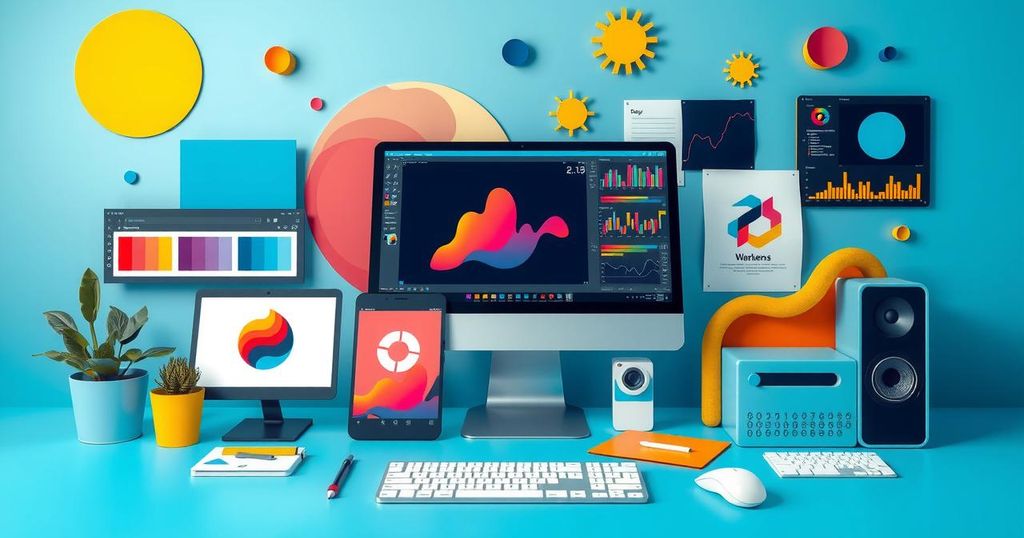Artificial intelligence is transforming Uganda’s graphic design sector by enhancing efficiency and productivity. However, industry experts assert that human creativity remains essential, as AI lacks emotional depth and cultural sensitivity. While AI tools facilitate rapid design production, they cannot replace the unique artistry that reflects Uganda’s cultural identity. The future lies in harmonizing AI use and human creativity for a richer design landscape.
The graphic design sector in Uganda is undergoing significant changes due to the swift adoption of artificial intelligence (AI) tools. In urban centers like Kampala and smaller commercial districts, AI is altering how designers create visuals, improve workflows, and cater to the burgeoning digital and print markets. Despite the advantages of this technology, many industry experts and local creatives stress that human creativity is indispensable, as graphic design is fundamentally linked to cultural expression and innovation.
AI-driven platforms such as Adobe Firefly, Canva’s AI features, and Midjourney are becoming increasingly popular among Ugandan designers. These tools enable designers to produce layouts, modify images, and create original works at a much faster rate. This enhanced efficiency presents significant opportunities, particularly for the numerous small businesses and startups that comprise Uganda’s market, by offering inexpensive, high-quality design solutions.
For instance, Jerome Tuhairwe, an independent designer in Kampala, utilizes AI to produce marketing materials. He asserts, “With AI, I can generate a poster design in minutes—what used to take me hours.” This capability has proven invaluable for meeting tight deadlines, especially when clients require immediate designs for events or product launches.
The printing sector, which plays a crucial role in advertising, has also reaped benefits from AI. Leading printing companies, such as MPK on Nasser Road, report that AI-generated designs are often pre-optimized, leading to fewer errors and faster production times. The trend towards the use of AI tools aligns with the overall shift in Uganda’s design field, as these technologies analyze market trends to recommend color palettes and layouts tailored to local preferences.
AI’s capacity to automate routine tasks such as resizing images and creating mockups has liberated designers’ time, enabling them to focus on more substantial projects. In a competitive environment that prioritizes efficiency and affordability, this advantage empowers smaller firms to compete effectively against larger established companies.
Digital printing operations are increasingly integrating AI to enhance their services. New AI software improves image quality, rectifies flaws, and predicts ink usage, thereby minimizing operational costs. As a professional graphic designer, I have observed tangible improvements; clients who previously encountered issues with pixelation or alignment now receive high-quality work because of AI’s refinements.
However, some critiques of AI’s role in Uganda’s graphic design field persist. Designers such as Peter Mugeni contend that while AI excels at efficiency, it often lacks the depth of creative insight and cultural awareness that defines Ugandan artistry. “AI can generate a design based on patterns it has learned, but it doesn’t understand the story behind a client’s brand,” he notes, highlighting AI’s limitations in cultural reflection.
Prof. Andrew P. Yiga from Nkumba University stresses the essential role that human intuition plays in design work. He states, “AI can analyze trends and replicate styles, but it lacks the lived experience and emotional depth that shape true artistic expression.” According to him, Ugandan design embodies culture and identity in ways that AI cannot grasp.
This limitation highlights the importance of contextual awareness in a nation where design is inextricably linked to cultural identity. For example, a recent AI-generated marketing campaign for a local coffee brand overlooked the significance of traditional coffee rituals in Bugisu culture, a detail a local designer would have included instinctively.
AI’s pursuit of perfection can often clash with the artisanal nature of traditional printing methods. Techniques such as screen printing and offset lithography require a level of craftsmanship that AI has not yet achieved. “There’s a warmth in the slight imperfections of a hand-printed poster that AI simply can’t provide,” asserts Mugeni, emphasizing the ongoing preference for genuine human touch in design.
As the domain of creativity remains a stronghold for human designers, it is clear that while AI can produce visually pleasing designs, it cannot innovate outside the bounds of its training datasets. Originality derived from personal intuition and experience, critical in distinguishing brands, remains a human asset. Designers and educators caution against the risk of homogenized design should AI be over-utilized at the expense of Uganda’s unique artistic expression.
As AI continues to influence Uganda’s graphic design industry, it is evident that it serves as a powerful tool rather than a replacement. Designers and printers are beginning to merge AI’s efficiencies with their own creativity, creating workflows that combine technological benefits with human insights. The forthcoming challenge is to embrace AI’s capabilities while preserving the essence of their craft. While AI may evolve to comprehend cultural subtleties better, the human touch persists as the heart of graphic design, reaffirming that although AI can create the framework, it is the designer who imbues it with life.
In this increasingly mechanized era, graphic designers and printers affirm that creativity rooted in human experience and cultural identity is invaluable and remains essential to their work.
In summary, while AI is rapidly transforming Uganda’s graphic design landscape by enhancing efficiency and creativity, it cannot replace the essential human elements of artistry and cultural understanding. Designers emphasize the importance of personal intuition, emotional depth, and cultural identity in the design process. As the industry adapts to new technologies, it will be crucial to blend AI’s advantages with human creativity to maintain the uniqueness of Uganda’s artistic expression going forward.
Original Source: www.independent.co.ug




